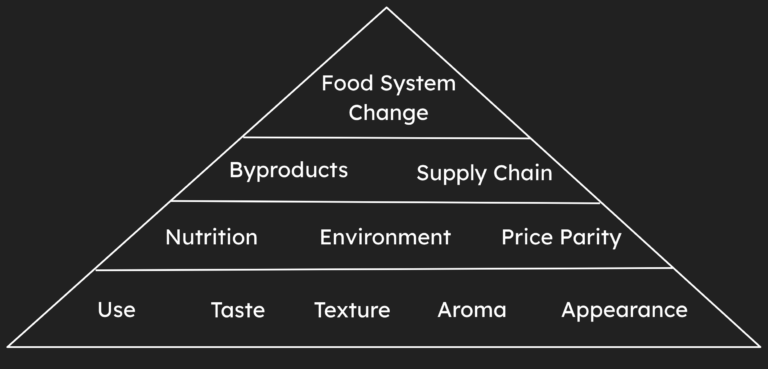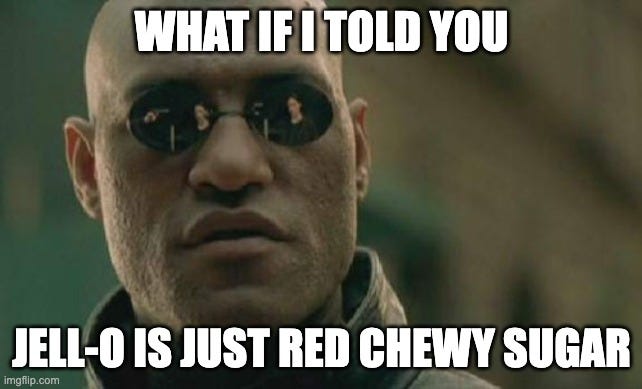Today, we’re exploring the fabric of culinary experiences – texture. Often overshadowed by taste and aroma, texture is a titan in its own right, profoundly shaping our food preferences and consumption patterns. Let’s dissect how texture weaves into this Hierarchy for Food System Change framework, influencing everything from nutrition to environmental sustainability.
what is texture in food?
In the realm of our Hierarchy, texture is a cornerstone. It’s not merely about the crunch or the creaminess; it’s about how these tactile sensations shape our food’s usability and desirability. Texture considerations are made when making food all the time – do you want your potatoes to be prepared as a super smooth purée or do you want stragglers that missed the immersion blender and leave you with something more toothsome? Should this cocktail have more body or should it be crisp and smooth? Textural aspects warp taste and aroma because they become more or less available, which we’ll chat on later.
So, the way a food is cooked has a profound effect on how much you desire to eat it. Broccoli that has been poached briefly rather than boiled to hell is a perfect dish to consider. I think that the trope that many children don’t want to eat their broccoli comes from home cooks that overcook vegetables – whether frozen, fresh, or canned – and then expect a kid to love the mushy texture. Presenting foods with many different textural elements can elicit new ways of preparing a dish. Take for example these broccoli – once you learn the way you like to eat them you might reach for broccoli rabe, brussels sprouts, or sunchokes to cook the same way and bring new dimensions in texture, flavor and more.
how do we sense texture?
Diving into the science of texture, it’s a symphony of physics and chemistry. We perceive texture from how food behaves under mechanical forces – like biting, chewing, interaction with our tongue, swallowing and sound. It isn’t a static aspect of food that stops when we are done cooking. Rather, it’s a dynamic element that changes while we chew or drink it. We have mechanoreceptors in our mouth, jaw, lips and tongue that can sense pressure, heat, cold and pain. This is similar to how our skin detects these same sensations. In the case of food though, these are hyper sensitive to the amount of force we need to bite down on a chip to sense a crunch, and then the reverberation of this crunch signals a sound to our ears to let us know the intensity of the crunch. There are instruments that food scientists will use to even determine the exact force that it would take someone to break down a chip to make it the most satisfying crunch imaginable. The human jaw can bite down from 120-165 psi, though we normally eat in the 70 psi area. Despite that, we can sense pressure from crunch, typically called the hardness of a food, to a small fraction of this number. So you will notice the difference in crunchiness between Lay’s that comes from a fresh bag of chips and a stale bag that’s been sitting around in the cupboard for a few days.
When texture is applied to liquids, we can start to think of how much a food is a liquid versus how much it is like a solid. All liquids are on this spectrum of being able to flow more, like water, or less, like molasses. These differences are looked at using a rheometer, literally the measure of (meter) flow (rheo). I’m not the best at rheometry, but it’s interesting to see how foods you consider to be firm solids, like a marshmallow, still have a liquid flow aspect to them and are not simply solids. If you want to go even deeper into the flow, I would say to check out this other science called tribology, which studies how two surfaces interact relative to their motion. Rheology only looks at the dish prepared and how it flows, but tribology starts to look at how foods that are continually broken into small bits through chewing continuously change how they interact with the inside of your mouth. You can almost think of rheology as the first order mechanics of a food texture, and tribology as the second order. Let’s skip the calculus lesson and talk about how we can change textures for something new and surprising.
how can we modify texture?
One of the reasons I was interested in cuisine was the work of Ferran Adrià and his legendary Spanish restaurant, El Bulli. Chef Adrià brought molecular gastronomy into cooking by looking at technologies that are used in large food manufacturing and exploring how to use them in fine dining. This spurred many great American chefs like Wylie Dufresne of wd~50 and Grant Achatz of Alinea, European chefs like René Redzepi of noma and Massimo Bottura of Osteria Francescana to continue these explorations. El Bulli developed chefs that explored how texture can be applied in dishes by retaining flavors and aromas while rebuilding new and unexplored textures.
One of the most iconic ways that El Bulli explored this was by bringing the espuma to the world of gastronomy. Espuma is the Spanish word for foam and can be made using texturizing products like gellan gum, carrageenans, agar, xanthan gum, gelatin and more to give structure to savory foods. They also have different gases pumped into them, like whipped cream canisters do, but obviously tasting wildly different. Many of these gums come from seaweed species or are products of fermentation that had rarely been used in kitchens prior to El Bulli. You can buy these products and make savory espumas that can change how you might eat a French onion soup or something iconic like Thanksgiving dinner.
Another interesting texturizing play was using extreme cooling with liquid nitrogen to show you can get crunchy and cold varieties of savory dishes that you could never consider previously. Clearly, many of these techniques are not what you’re going to use on a Wednesday night when you just want to chill, but they open your eyes to novel experiences, without a doubt.
texture interactions with taste and aroma
I had talked about taste and the compounds that interact with your tastebuds. We’ll chat about aroma in a few weeks, but lean into your knowledge of how your sniffer works and take a jog with me through this new structural paradigm. Taste compounds are released as you chew or work a drink in your mouth. Texture plays with the flow and breakdown of the food itself, and that impacts how taste and aroma compounds are released. Depending on the size of the compound and how it fits into the food, these taste compounds can be locked in, in a word, and can’t fully express themselves in a dish. If they’re constrained, they’ll never reach your taste buds. This can be a positive thing! Maybe a bitter component is overwhelming and you want to skip over it, but it can also be negative by the same means. You’ll notice that there isn’t a lot of taste complexity going on with jell-o (unless there’s a lil vodka in it lol), and that’s because taste and aroma get “trapped” in the jell-o matrix so you’re left with red chewy sugar with La Croix levels of taste.
so why does this matter in the landscape of the Hierarchy?
More than anything, texture influences our choices, shapes our cultural culinary landscapes, and holds immense potential for driving sustainable change. When you have spinach that’s wilted, can you prepare it in a way to revitalize its texture so that it’s not wasted? I know it’s hard to see how texture alone may drive positive change and that’s mainly because it sits in the back of our collective mind. It is part of the tie-dyed tapestry that hangs in the dorm room of a burgeoning new Food System. The hype is real around taste and aroma, but texture gives a podium for those two to shine.





